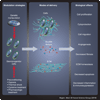Stem cell paracrine actions and tissue regeneration
- PMID: 20017699
- PMCID: PMC2833273
- DOI: 10.2217/rme.09.74
Stem cell paracrine actions and tissue regeneration
Abstract
Stem cells have emerged as a key element of regenerative medicine therapies due to their inherent ability to differentiate into a variety of cell phenotypes, thereby providing numerous potential cell therapies to treat an array of degenerative diseases and traumatic injuries. A recent paradigm shift has emerged suggesting that the beneficial effects of stem cells may not be restricted to cell restoration alone, but also due to their transient paracrine actions. Stem cells can secrete potent combinations of trophic factors that modulate the molecular composition of the environment to evoke responses from resident cells. Based on this new insight, current research directions include efforts to elucidate, augment and harness stem cell paracrine mechanisms for tissue regeneration. This article discusses the existing studies on stem/progenitor cell trophic factor production, implications for tissue regeneration and cancer therapies, and development of novel strategies to use stem cell paracrine delivery for regenerative medicine.
Figures
References
-
- Scadden DT. The stem-cell niche as an entity of action. Nature. 2006;441(7097):1075–1079. - PubMed
-
- Kilroy GE, Foster SJ, Wu X, et al. Cytokine profile of human adipose-derived stem cells: expression of angiogenic, hematopoietic, and proinflammatory factors. J. Cell. Physiol. 2007;212(3):702–709. - PubMed
-
- Sarojini H, Estrada R, Lu H, et al. PEDF from mouse mesenchymal stem cell secretome attracts fibroblasts. J. Cell. Biochem. 2008;104(5):1793–1802. - PubMed
-
- Schinkothe T, Bloch W, Schmidt A. In vitro secreting profile of human mesenchymal stem cells. Stem Cells Dev. 2008;17(1):199–206. - PubMed
Publication types
MeSH terms
Grants and funding
LinkOut - more resources
Full Text Sources
Other Literature Sources
Medical

